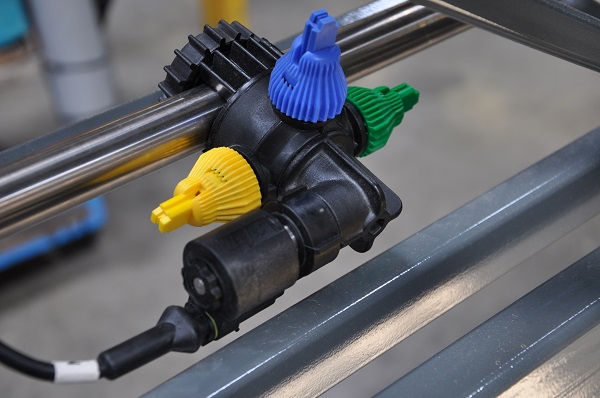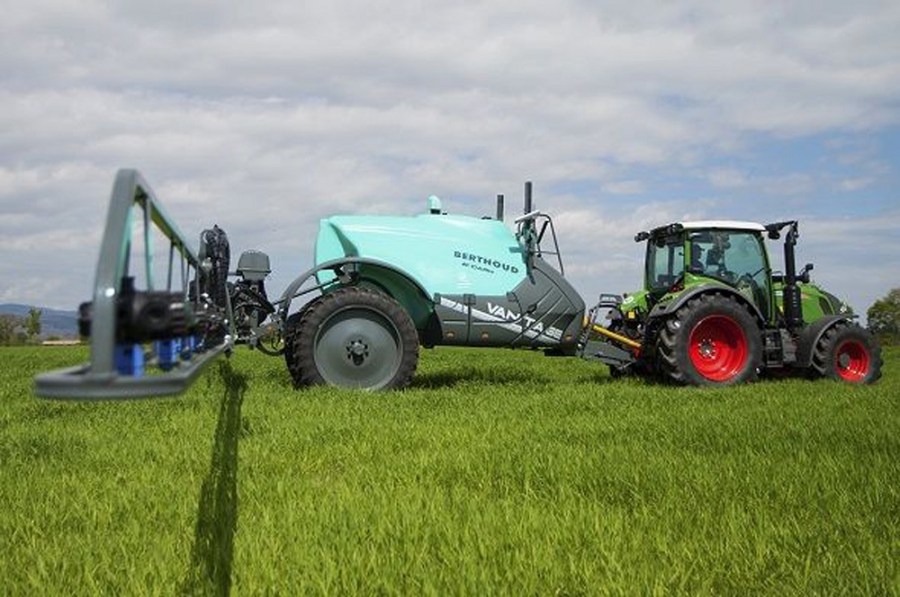New technology from French sprayer maker Berthoud is claimed to reduce the requirement for nozzle changes. CPM visited the firm’s factory to find out more about this and other tech developments.
What we wanted to achieve was a method of not only increasing the working range of the sprayer, but also the consistency of spray quality.
By Martin Rickatson
Nozzle-changing might not be the most time-consuming, complicated or costly activity in terms of machinery tasks, but for many sprayer operators on large-scale arable enterprises, making many passes with wide-boom machines across big acreages and multiple crops, it’s unlikely to be high up on a list of favourite farm jobs.
Changes in crop type and stage, wind speed and weather windows can all require quick nozzle changes in order to ensure critical crop growth stage timings aren’t missed, and crops receive the required coverage and dose. Developments in manually or remotely adjustable multi-nozzle bodies may have alleviated some of the monotony and hassle of the task of adapting to changing conditions before a spraying task begins. But they can’t do so once the machine is on the move. The result is an inflexible system that means neither speed nor rate can be varied once work is underway, suggests Berthoud.

The system means flow can be varied by as much as 70% from a single nozzle type without changing operating pressure.
The firm’s answer has been to develop what it says is a simple, swift low-cost solution to an on-the-move need for finer or coarser sprays. Its Spraytronic development is one of a package of new technologies Berthoud has recently introduced for its Vantage trailed and Raptor self-propelled sprayers. To maintain spray quality from a particular nozzle type, operators are usually limited to a relatively narrow working speed range to ensure droplets are neither too fine nor too coarse, points out Francois-Xavier Janin, product manager for the firm.
“When our research and development team looked at possible solutions to this, altering the nozzle outputs using solenoids seemed the most logical solution, given the speed with which they can operate,” he explains.
“What we wanted to achieve was a method of not only increasing the working range of the sprayer, but also the consistency of spray quality. That led to the development of Spraytronic, a system which incorporates solenoids in each of the nozzle bodies.
“These allow the ratio of the opening and closing time of each solenoid, which takes place up to 20 times per second, to be varied at a fixed frequency according to the speed variation of the tractor or self-propelled tractor unit. It works on an easy-to-use principle: the user simply selects the nozzle to be used, the operating pressure and the volume per ha.”
The result is that that flow can be varied by as much as 70% from a single nozzle type, while a similar variation is possible in forward speed, all without changing operating pressure.
“This means it’s possible to use the same 3.0 bar-rated nozzle across a speed range from 8-18 km/h,” says Francois-Xavier.
“With the ability to thereby cover a wide variety of crop and climate circumstances with a single nozzle, there’s therefore no need to invest in a large number of nozzles, or spend time and money changing or maintaining them.
“It also means pressure doesn’t vary due to a change of nozzle type, and provides the possibility to enter a desired operating pressure to alter output, while also enabling the use of a standard nozzle holder.
“This technology also offers the potential for modulating output and cutting off flow nozzle by nozzle, for variable application.”
The Spraytronic system is the key new technology on two recently introduced sprayer ranges from Berthoud – the revised Raptor front and mid-cabbed self-propelled sprayers and the new Vantage Dark trailed range. The latter was the winner of the Machine of the Year title for its category when launched at last year’s SIMA show. But the Vantage Dark models, available in 2800, 3500, 4300, 5500 and 6700-litre capacities, and with steel and aluminium boom sizes from 24-44m, feature a number of other new technologies as either standard or optional specification.
All are based on a single-piece, twin-beam chassis built to a short design said to ease headland turning and minimise drift on slopes. Working independently of load, Berthoud’s patented, improved Actiflex 2 mechanical suspension cushions the sprayer from shocks that would otherwise be transferred to the extended boom via the axle, as well as protecting the machine from damage on rough road surfaces when between jobs.
Sited close to the base of the tank to minimise unsprayed residue, at the heart of the spraying equipment itself is a twin-turbine Omega centrifugal pump, with a maximum capacity of 550 l/min at 3.0 bar pressure. Chemical filling takes place via a newly designed 35-litre induction hopper, while external controls are based on either DualMatic manual or DualElec electronically controlled valve operation. Both use the BerLogic numbered system to help make valve choices simple and avoid confusion. But while the former is based on a pair of manually operated rotary valves, the latter is an electronically controlled system, with the control interface at the sprayer mirrored by a similar one in the cab.
“The reliability of such systems has been proven over more than a decade now,” notes Martin Shackloth, Berthoud UK sales manager.
“Reduced pipework is one of the most significant advantages, helping to minimise the amount of unsprayed residue that would otherwise remain in the sprayer.”
The basic controller for the Vantage Dark is the EC Tronic terminal, which has a 15cm colour screen that displays information on volume per ha, measured pressure and litres applied. Via CANBUS technology it allows control of up to 15 individual sections, and it can be fitted with the optional E-Tech package for control of guidance, section shut-off and variable rate application.
As standard, all Vantage Dark controller solutions are supplied with Berthoud’s wireless joystick, allowing thumb-operated control and providing a wireless working range of up to 20m for situations such as locating a blocked nozzle or measuring nozzle output from outside the cab. EC Tronic is pre-configured with GPS section shut-off through a wire connection, but can also be fitted with an optional RS232 connection or an ISOBUS connector for GPS section shut-off and variable rate application.
As an alternative, buyers can specify the all-in-one VT Tronic ISOBUS universal terminal, based on Trimble’s TMX 2050. This provides single-terminal touchscreen control for flow management, GPS functions, automatic shut-off and variable-rate application. Finally, the Vantage Dark is also available in IsoTronic fully ISOBUS-compatible specification, allowing users to control the machine through any ISOBUS tractor terminal.
“In this sector of the market, there’s a good deal of interest in specifying a sprayer with features that do as much as possible to improve ease of operation,” says Martin.
“To that end, VT Tronic and IsoTronic-equipped Vantage Dark models were among the first to be sold to UK buyers in time for this season.”
Mounted and self-propelled developments
While upgrades to its top-end trailed sprayers represent probably the biggest news from Berthoud in terms of 2018 developments, there’s also a new mounted machine range from the firm. Capacity of the Hermes line currently tops out at 1200 litres, although Berthoud offers front tanks to match, and larger models may be in the pipeline.
A new hitch design brings the sprayer closer to the tractor for improved weight distribution, while a new EcoMatic valve block, on which a patent is pending, features a completely revised valve block and minimal distance between valves and pump, to minimise residual volumes.
“We carried out a lot of customer research before planning a revision of the valve system for this range, and much of the feedback suggested simplicity was the trait most sprayer operators were looking for,” says Francois-Xavier Janin.
“Minimising the amount of unsprayed residue will likely become a more and more important issue as farmers are required to account for almost every drop of product, and of course it only does its job in the field, not when it remains in the sprayer’s plumbing. Our testing of this system, which incorporates our own pump, designed with the same focus in mind, has shown we’ve reduced residue volumes by 50%.”
Meanwhile, there are also updates to its self-propelled Raptor line, which can now also be equipped with Spraytronic. The machines also benefit from an upgraded Bosch Rexroth three-range hydrostatic transmission, with cruise control and a new ‘eco’ mode to minimise fuel use during road travel, plus front and rear diff locks to aid traction. Meanwhile, for the Raptor 4240, there’s now a hydraulic track width and ride height adjustment option. The range for the former is 2.25-2.95m, or 2.40-3.05m, while for the latter it spans 1.25-1.80m.
A bit about Berthoud
Founded in 1895 in the heart of the Beaujolais vineyards, Berthoud began by making backpack sprayers, made from copper tanks, for treating vines. Part of the Exel Industries group since 1987, today it markets its sprayers through importers around the world, but the UK is one of only a handful of countries in which it operates its own subsidiary to sell and support its machines.
At its 5ha site in Belleville, Berthoud’s 22,000 m² facilities, built in 2001, are home to a staff of around 200, aided by 20 temporary workers manufacturing and providing service, parts and administration support for its international activities. They assemble around 15-20 mounted, 30 trailed and 4-5 self-propelled sprayers each week, with 220,000 possible machine variations according to the customer’s required specification. Depending on type, format and specification, the average sprayer consists of 2500-3500 separate components.
“That starts at the most basic level because, for example, we offer both front and mid-mounted cab variants of the Raptor self-propelled sprayers,” points out Martin Shackloth.
“Four years ago, 60% of Berthoud sales were in France, but now that same proportion is accounted for by export sales, and the UK is one of the company’s most important markets. It’s always had its distinctive characteristics, but those are shifting. For example, while UK self-propelled buyers have traditionally favoured front-mounted cabs, we’ve seen demand for our Raptor models develop into a 50:50 split between this design and the mid-mounted alternative we also offer.
“The self-propelled base units are built by Preciculture, another firm within the Exel Industries group, but the spraypacks are created by our own design engineers and factory team. Just as we’re still seeing farms move from mounted sprayers to trailed, so we’re also finding more customers upgrading from trailed to self-propelled machines, particularly as we can offer them that choice of format, as well as, with the front-cabbed models, the option of hydraulic raise/lower capability.
“Of course, there are also plenty of farms who are happy to continue running a trailed sprayer, but again they increasingly tend to be looking for more advanced specification and enhanced capabilities when replacement time comes. The Vantage now meets that demand.”




